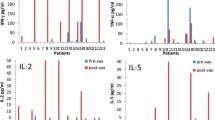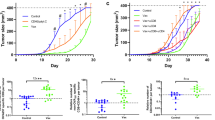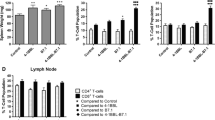Abstract
In mice, vaccination with high peptide doses generates higher frequencies of specific CD8+ T cells, but with lower avidity compared to vaccination with lower peptide doses. To investigate the impact of peptide dose on CD8+ T cell responses in humans, melanoma patients were vaccinated with 0.1 or 0.5 mg Melan-A/MART-1 peptide, mixed with CpG 7909 and Incomplete Freund’s adjuvant. Neither the kinetics nor the amplitude of the Melan-A-specific CD8+ T cell responses differed between the two vaccination groups. Also, CD8+ T cell differentiation and cytokine production ex vivo were similar in the two groups. Interestingly, after low peptide dose vaccination, Melan-A-specific CD8+ T cells showed enhanced degranulation upon peptide stimulation, as assessed by CD107a upregulation and perforin release ex vivo. In accordance, CD8+ T cell clones derived from low peptide dose-vaccinated patients showed significantly increased degranulation and stronger cytotoxicity. In parallel, Melan-A-specific CD8+ T cells and clones from low peptide dose-vaccinated patients expressed lower CD8 levels, despite similar or even stronger binding to tetramers. Furthermore, CD8+ T cell clones from low peptide dose-vaccinated patients bound CD8 binding-deficient tetramers more efficiently, suggesting that they may express higher affinity TCRs. We conclude that low peptide dose vaccination generated CD8+ T cell responses with stronger cytotoxicity and lower CD8 dependence.





Similar content being viewed by others
References
Jaeger E, Bernhard H, Romero P, Ringhoffer M, Arand M, Karbach J, Ilsemann C, Hagedorn M, Knuth A (1996) Generation of cytotoxic T-cell responses with synthetic melanoma-associated peptides in vivo: implications for tumor vaccines with melanoma-associated antigens. Int J Cancer 66(2):162–169. doi:10.1002/(SICI)1097-0215(19960410)66:2<162:AID-IJC4>3.0.CO;2-0
Cormier JN, Salgaller ML, Prevette T, Barracchini KC, Rivoltini L, Restifo NP, Rosenberg SA, Marincola FM (1997) Enhancement of cellular immunity in melanoma patients immunized with a peptide from MART-1/Melan A. Cancer J Sci Am 3(1):37–44
Speiser DE, Lienard D, Rufer N, Rubio-Godoy V, Rimoldi D, Lejeune F, Krieg AM, Cerottini JC, Romero P (2005) Rapid and strong human CD8+ T cell responses to vaccination with peptide, IFA, and CpG oligodeoxynucleotide 7909. J Clin Invest 115(3):739–746. doi:10.1172/JCI23373
Speiser DE, Romero P (2010) Molecularly defined vaccines for cancer immunotherapy, and protective T cell immunity. Semin Immunol 22(3):144–154. doi:10.1016/j.smim.2010.03.004
Rizzuto GA, Merghoub T, Hirschhorn-Cymerman D, Liu C, Lesokhin AM, Sahawneh D, Zhong H, Panageas KS, Perales MA, Altan-Bonnet G, Wolchok JD, Houghton AN (2009) Self-antigen-specific CD8+ T cell precursor frequency determines the quality of the antitumor immune response. J Exp Med 206(4):849–866. doi:10.1084/jem.20081382
Venturi V, Price DA, Douek DC, Davenport MP (2008) The molecular basis for public T-cell responses? Nat Rev Immunol 8(3):231–238. doi:10.1038/nri2260
Derby M, Alexander-Miller M, Tse R, Berzofsky J (2001) High-avidity CTL exploit two complementary mechanisms to provide better protection against viral infection than low-avidity CTL. J Immunol 166(3):1690–1697
Alexander-Miller MA, Leggatt GR, Berzofsky JA (1996) Selective expansion of high- or low-avidity cytotoxic T lymphocytes and efficacy for adoptive immunotherapy. Proc Natl Acad Sci USA 93(9):4102–4107
Bennett MS, Ng HL, Dagarag M, Ali A, Yang OO (2007) Epitope-dependent avidity thresholds for cytotoxic T-lymphocyte clearance of virus-infected cells. J Virol 81(10):4973–4980. doi:10.1128/JVI.02362-06
Speiser DE, Kyburz D, Stubi U, Hengartner H, Zinkernagel RM (1992) Discrepancy between in vitro measurable and in vivo virus neutralizing cytotoxic T cell reactivities. Low T cell receptor specificity and avidity sufficient for in vitro proliferation or cytotoxicity to peptide-coated target cells but not for in vivo protection. J Immunol 149(3):972–980
Zeh HJ 3rd, Perry-Lalley D, Dudley ME, Rosenberg SA, Yang JC (1999) High avidity CTLs for two self-antigens demonstrate superior in vitro and in vivo antitumor efficacy. J Immunol 162(2):989–994
Yee C, Savage PA, Lee PP, Davis MM, Greenberg PD (1999) Isolation of high avidity melanoma-reactive CTL from heterogeneous populations using peptide-MHC tetramers. J Immunol 162(4):2227–2234
Sedlik C, Dadaglio G, Saron MF, Deriaud E, Rojas M, Casal SI, Leclerc C (2000) In vivo induction of a high-avidity, high-frequency cytotoxic T-lymphocyte response is associated with antiviral protective immunity. J Virol 74(13):5769–5775
Belyakov IM, Kuznetsov VA, Kelsall B, Klinman D, Moniuszko M, Lemon M, Markham PD, Pal R, Clements JD, Lewis MG, Strober W, Franchini G, Berzofsky JA (2006) Impact of vaccine-induced mucosal high-avidity CD8+ CTLs in delay of AIDS viral dissemination from mucosa. Blood 107(8):3258–3264. doi:10.1182/blood-2005-11-4374
Almeida JR, Price DA, Papagno L, Arkoub ZA, Sauce D, Bornstein E, Asher TE, Samri A, Schnuriger A, Theodorou I, Costagliola D, Rouzioux C, Agut H, Marcelin AG, Douek D, Autran B, Appay V (2007) Superior control of HIV-1 replication by CD8+ T cells is reflected by their avidity, polyfunctionality, and clonal turnover. J Exp Med 204(10):2473–2485. doi:10.1084/jem.20070784
Neveu B, Debeaupuis E, Echasserieau K, le Moullac-Vaidye B, Gassin M, Jegou L, Decalf J, Albert M, Ferry N, Gournay J, Houssaint E, Bonneville M, Saulquin X (2008) Selection of high-avidity CD8 T cells correlates with control of hepatitis C virus infection. Hepatology 48(3):713–722. doi:10.1002/hep.22379
Harari A, Dutoit V, Cellerai C, Bart PA, Du Pasquier RA, Pantaleo G (2006) Functional signatures of protective antiviral T-cell immunity in human virus infections. Immunol Rev 211:236–254. doi:10.1111/j.0105-2896.2006.00395.x
Yuan J, Gnjatic S, Li H, Powel S, Gallardo HF, Ritter E, Ku GY, Jungbluth AA, Segal NH, Rasalan TS, Manukian G, Xu Y, Roman RA, Terzulli SL, Heywood M, Pogoriler E, Ritter G, Old LJ, Allison JP, Wolchok JD (2008) CTLA-4 blockade enhances polyfunctional NY-ESO-1 specific T cell responses in metastatic melanoma patients with clinical benefit. Proc Natl Acad Sci USA 105(51):20410–20415. doi:10.1073/pnas.0810114105
Appay V, Douek DC, Price DA (2008) CD8+ T cell efficacy in vaccination and disease. Nat Med 14(6):623–628. doi:10.1038/nm.f.1774
Harty JT, Badovinac VP (2008) Shaping and reshaping CD8+ T-cell memory. Nat Rev Immunol 8(2):107–119. doi:10.1038/nri2251
Bullock TN, Mullins DW, Engelhard VH (2003) Antigen density presented by dendritic cells in vivo differentially affects the number and avidity of primary, memory, and recall CD8+ T cells. J Immunol 170(4):1822–1829
Hamilton SE, Harty JT (2002) Quantitation of CD8+ T cell expansion, memory, and protective immunity after immunization with peptide-coated dendritic cells. J Immunol 169(9):4936–4944
Kochenderfer JN, Chien CD, Simpson JL, Gress RE (2007) Maximizing CD8+ T cell responses elicited by peptide vaccines containing CpG oligodeoxynucleotides. Clin Immunol 124(2):119–130. doi:10.1016/j.clim.2007.04.003
Narayan S, Choyce A, Fernando GJ, Leggatt GR (2007) Secondary immunisation with high-dose heterologous peptide leads to CD8 T cell populations with reduced functional avidity. Eur J Immunol 37(2):406–415. doi:10.1002/eji.200535688
Vitiello A, Ishioka G, Grey HM, Rose R, Farness P, LaFond R, Yuan L, Chisari FV, Furze J, Bartholomeuz R et al (1995) Development of a lipopeptide-based therapeutic vaccine to treat chronic HBV infection. I. Induction of a primary cytotoxic T lymphocyte response in humans. J Clin Invest 95(1):341–349. doi:10.1172/JCI117662
Audran R, Lurati-Ruiz F, Genton B, Blythman HE, Ofori-Anyinam O, Reymond C, Corradin G, Spertini F (2009) The synthetic Plasmodium falciparum circumsporozoite peptide PfCS102 as a malaria vaccine candidate: a randomized controlled phase I trial. PLoS One 4(10):e7304. doi:10.1371/journal.pone.0007304
Greiner J, Schmitt A, Giannopoulos K, Rojewski MT, Gotz M, Funk I, Ringhoffer M, Bunjes D, Hofmann S, Ritter G, Dohner H, Schmitt M (2010) High-dose RHAMM-R3 peptide vaccination for patients with acute myeloid leukemia, myelodysplastic syndrome and multiple myeloma. Haematologica 95(7):1191–1197. doi:10.3324/haematol.2009.014704
Klade CS, Wedemeyer H, Berg T, Hinrichsen H, Cholewinska G, Zeuzem S, Blum H, Buschle M, Jelovcan S, Buerger V, Tauber E, Frisch J, Manns MP (2008) Therapeutic vaccination of chronic hepatitis C nonresponder patients with the peptide vaccine IC41. Gastroenterology 134(5):1385–1395. doi:10.1053/j.gastro.2008.02.058
Firbas C, Jilma B, Tauber E, Buerger V, Jelovcan S, Lingnau K, Buschle M, Frisch J, Klade CS (2006) Immunogenicity and safety of a novel therapeutic hepatitis C virus (HCV) peptide vaccine: a randomized, placebo controlled trial for dose optimization in 128 healthy subjects. Vaccine 24(20):4343–4353. doi:10.1016/j.vaccine.2006.03.009
Speiser DE, Baumgaertner P, Barbey C, Rubio-Godoy V, Moulin A, Corthesy P, Devevre E, Dietrich PY, Rimoldi D, Lienard D, Cerottini JC, Romero P, Rufer N (2006) A novel approach to characterize clonality and differentiation of human melanoma-specific T cell responses: spontaneous priming and efficient boosting by vaccination. J Immunol 177(2):1338–1348
Wieckowski S, Baumgaertner P, Corthesy P, Voelter V, Romero P, Speiser DE, Rufer N (2009) Fine structural variations of alphabetaTCRs selected by vaccination with natural versus altered self-antigen in melanoma patients. J Immunol 183(8):5397–5406. doi:10.4049/jimmunol.0901460
Pittet MJ, Valmori D, Dunbar PR, Speiser DE, Lienard D, Lejeune F, Fleischhauer K, Cerundolo V, Cerottini JC, Romero P (1999) High frequencies of naive Melan-A/MART-1-specific CD8(+) T cells in a large proportion of human histocompatibility leukocyte antigen (HLA)-A2 individuals. J Exp Med 190(5):705–715
Altman JD, Moss PA, Goulder PJ, Barouch DH, McHeyzer-Williams MG, Bell JI, McMichael AJ, Davis MM (1996) Phenotypic analysis of antigen-specific T lymphocytes. Science 274(5284):94–96
Purbhoo MA, Boulter JM, Price DA, Vuidepot AL, Hourigan CS, Dunbar PR, Olson K, Dawson SJ, Phillips RE, Jakobsen BK, Bell JI, Sewell AK (2001) The human CD8 coreceptor effects cytotoxic T cell activation and antigen sensitivity primarily by mediating complete phosphorylation of the T cell receptor zeta chain. J Biol Chem 276(35):32786–32792
Pittet MJ, Rubio-Godoy V, Bioley G, Guillaume P, Batard P, Speiser D, Luescher I, Cerottini JC, Romero P, Zippelius A (2003) Alpha 3 domain mutants of peptide/MHC class I multimers allow the selective isolation of high avidity tumor-reactive CD8 T cells. J Immunol 171(4):1844–1849
Rufer N, Reichenbach P, Romero P (2005) Methods for the ex vivo characterization of human CD8+ T subsets based on gene expression and replicative history analysis. Methods Mol Med 109:265–284
Wonderlich J, Shearer G, Livingstone A, Brooks A (2006) Induction and measurement of cytotoxic T lymphocyte activity, Chapter 3, Unit 3.11. Curr Protoc Immunol. doi:10.1002/0471142735.im0311s72
Speiser DE, Migliaccio M, Pittet MJ, Valmori D, Lienard D, Lejeune F, Reichenbach P, Guillaume P, Luscher I, Cerottini JC, Romero P (2001) Human CD8(+) T cells expressing HLA-DR and CD28 show telomerase activity and are distinct from cytolytic effector T cells. Eur J Immunol 31(2):459–466. doi:10.1002/1521-4141(200102)31:2<459::AID-IMMU459>3.0.CO;2-Y
Romero P, Zippelius A, Kurth I, Pittet MJ, Touvrey C, Iancu EM, Corthesy P, Devevre E, Speiser DE, Rufer N (2007) Four functionally distinct populations of human effector-memory CD8+ T lymphocytes. J Immunol 178(7):4112–4119
Betts MR, Brenchley JM, Price DA, De Rosa SC, Douek DC, Roederer M, Koup RA (2003) Sensitive and viable identification of antigen-specific CD8+ T cells by a flow cytometric assay for degranulation. J Immunol Methods 281(1–2):65–78
Makedonas G, Banerjee PP, Pandey R, Hersperger AR, Sanborn KB, Hardy GA, Orange JS, Betts MR (2009) Rapid up-regulation and granule-independent transport of perforin to the immunological synapse define a novel mechanism of antigen-specific CD8+ T cell cytotoxic activity. J Immunol 182(9):5560–5569. doi:10.4049/jimmunol.0803945
Powell DJ Jr, Rosenberg SA (2004) Phenotypic and functional maturation of tumor antigen-reactive CD8+ T lymphocytes in patients undergoing multiple course peptide vaccination. J Immunother 27(1):36–47
Maile R, Siler CA, Kerry SE, Midkiff KE, Collins EJ, Frelinger JA (2005) Peripheral “CD8 tuning” dynamically modulates the size and responsiveness of an antigen-specific T cell pool in vivo. J Immunol 174(2):619–627
Park JH, Adoro S, Lucas PJ, Sarafova SD, Alag AS, Doan LL, Erman B, Liu X, Ellmeier W, Bosselut R, Feigenbaum L, Singer A (2007) ‘Coreceptor tuning’: cytokine signals transcriptionally tailor CD8 coreceptor expression to the self-specificity of the TCR. Nat Immunol 8(10):1049–1059. doi:10.1038/ni1512
Alexander-Miller MA (2005) High-avidity CD8+ T cells: optimal soldiers in the war against viruses and tumors. Immunol Res 31(1):13–24. doi:10.1385/IR:31:1:13
Xiao Z, Mescher MF, Jameson SC (2007) Detuning CD8 T cells: down-regulation of CD8 expression, tetramer binding, and response during CTL activation. J Exp Med 204(11):2667–2677. doi:10.1084/jem.20062376
Johansen P, Storni T, Rettig L, Qiu Z, Der-Sarkissian A, Smith KA, Manolova V, Lang KS, Senti G, Mullhaupt B, Gerlach T, Speck RF, Bot A, Kundig TM (2008) Antigen kinetics determines immune reactivity. Proc Natl Acad Sci USA 105(13):5189–5194. doi:10.1073/pnas.0706296105
Acknowledgments
We are obliged to patients and blood donors for their dedicated collaboration. We gratefully acknowledge L. J. Old, J. O’Donnell-Tormey, E. W. Hoffman, O. Michielin, A. Auteri, G. Berthod and K. Homicsko for their contributions, H. R. MacDonald, P. Romero, J. Skipper, H. F. Oettgen and H. Märki, for support, and P. Schneider, T. Brunner, E. Wattrang, H. Bouzourene, L. Baitsch, M. Braun, C. Meyer, A. Legat, D. Labes, M. Iancu, B. Gupta, J. -P. Rivals, L. Derré, C. Touvrey, K. Servis, L. Pan and R. Venhaus for collaboration and advice. We thank J. -M. Tiercy and V. Aubert for HLA typing, and Pfizer and Coley Pharmaceutical Group (USA) for providing CpG 7909 (PF-3512676). We are also thankful for the excellent help of C. Beauverd, C. Geldhof, L. Cagnon, L. Leyvraz, N. Montandon, E. Cuennet, and M. van Overloop. The study was supported by Swiss Cancer League grant 02279-08-2008, Swiss National Science Foundation, Swiss National Center of Competence in Research (NCCR) Molecular Oncology, Ludwig Institute for Cancer Research, Cancer Research Institute (USA), Cancer Vaccine Collaborative, and Atlantic Philanthropies (USA).
Author information
Authors and Affiliations
Corresponding author
Electronic supplementary material
Below is the link to the electronic supplementary material.
Rights and permissions
About this article
Cite this article
Lövgren, T., Baumgaertner, P., Wieckowski, S. et al. Enhanced cytotoxicity and decreased CD8 dependence of human cancer-specific cytotoxic T lymphocytes after vaccination with low peptide dose. Cancer Immunol Immunother 61, 817–826 (2012). https://doi.org/10.1007/s00262-011-1140-1
Received:
Accepted:
Published:
Issue Date:
DOI: https://doi.org/10.1007/s00262-011-1140-1




